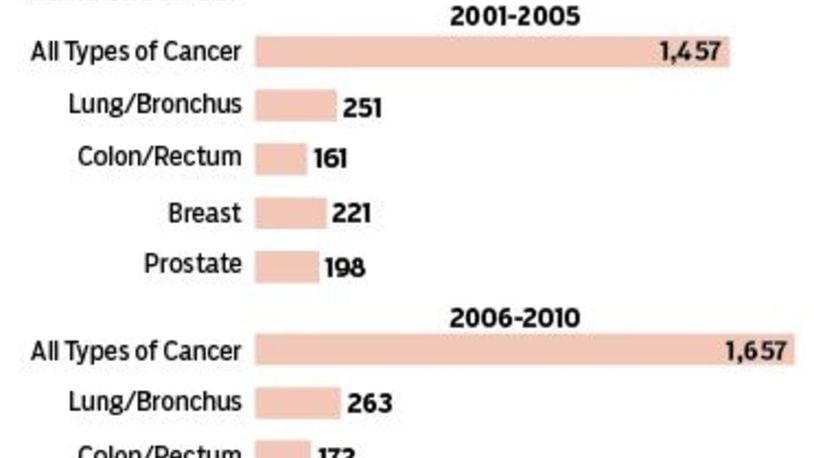Top 10 states for research grants from American Cancer Society
- California: 142 grants at $68.6 million
- New York: 96 grants at $49.3 million
- Massachusetts: 108 grants at $44 million
- Texas: 58 grants at $38 million
- Pennsylvania: 51 grants at $26.3 million
- Illinois: 46 grants at $24.7 million
- North Carolina: 47 grants at $22.5 million
- Michigan: 32 grants at $21.4 million
- Ohio: 35 grants at $20.1 million
- Maryland: 27 grants at $13 million
Source: American Cancer Society, as of Sept. 1, 2013
Despite millions of dollars tied to cancer research in Southwest Ohio, more cases of invasive cancer are cropping up each year in Butler County.
New four-year data from the Ohio Department of Health outlines a 14 percent increase in invasive cancer cases in Butler County each year from 2006 to 2010, as compared to years 2001 to 2005. The most common occurrences continue to be lung, breast, prostate and colon cancers.
An average of 1,657 cases of new invasive cancer were reported each year from 2006 to 2010. That rate was 1,457 during the previous reporting period, according to ODH.
“Lung cancer is this region will continue to be a problem,” said Shuk-Mei Ho, Ph.D, director of the Cincinnati Cancer Center. “Our residents have one of the highest smoking rates in the country.”
Also recording an uptick is the number of cancer deaths each year in the county. An average of 675 Butler County residents die each year from cancer — a 4 percent increase over the previous average of 648 deaths per year.
Ho said research over time has determined the two most common risk factors for developing cancer are smoking and pollution. She said someone living near a major highway, with more than 20,000 trucks passing, is at six times the risk of developing leukemia than someone living far from the highway.
Ho said other common risk factors in Greater Cincinnati include obesity, alcohol, cosmetic and health products containing estrogen, poor nutrition and a lack of exercise.
“Lifestyle is extremely important,” Ho said.
Bill Chambers, interim national vice president of extramural research for the American Cancer Society, said proactive measures including vaccinations against human papilloma virus (HPV) can reduce the chances of developing certain cancers later in life.
Paving the way for advancements in cancer research, the National Cancer Institute (NCI) reflects more than $102 million in active research efforts across Ohio. The American Cancer Society (ACS) currently has $20 million tied up in research grants to outside hospitals, universities, research centers and pharmaceutical companies in Ohio.
“There’s definitely more effort spent on more cancers than others when there’s greater incidence,” Chambers said. “You’re seeking to fund the best science and the best people.”
Through research, Chambers said advances in the causes and treatment of cancer have included using the immune system and therapeutic vaccinations to combat cancer and adoptive cellular immunotherapy to modify existing immune cells to shrink tumors.
Chambers said an advancement in studying one form of cancer can end up benefiting many types of the disease because of common traits shared among tumors.
“Ohio has a wealth of outstanding universities and cancer centers,” Chambers said. “It’s a state blessed with outstanding people doing cancer research.”
Chambers said about 15 percent of the ACS budget is dedicated to research. He said the majority of money spent by the ACS supports patient services and programs, such as the Hope Lodge and transportation.
Rachael Wyatt, of Fairfield Twp., said she’s been donating to the ACS for about three years since both her grandfather and aunt beat cancer diagnoses in the same year.
“I would like to see (donations) go to make people who are dealing with cancer to be comfortable,” Wyatt said. “As a reachable goal, attainable with the money earned, I see more need there.”
Wyatt, who joined the teaching staff at Ridgeway Elementary in Hamilton this year, said she’s also started fundraising efforts for the 2014 Relay for Life at Hamilton High School.
“Because there’s not much you can do when someone has cancer, except provide meals and support,” Wyatt said. “I wanted to be involved with the community, support people with cancer and give back to my family members.”
Suzanne Coleman, director of Kettering Health Network’s Innovation Center, said another avenue for cancer research is the use of clinical trials to test new treatments and drugs. The Kettering network, which includes Fort Hamilton Hospital, enrolled 184 people into cancer studies last year.
“I’m incredibly hopeful when I think of progress in breast cancer and survival, genetics and the root cause of the disease,” Coleman said.
The health network has access to more than 200 clinical trials through associations with organizations including University of Cincinnati and the Dayton Clinical Oncology Program, Coleman said.
“We encourage people to try other options; (trials) are a treatment that otherwise wouldn’t be available to them,” Coleman said. “We give people extra months, if not years, because of our multidisciplinary approach to manage the patient’s care,” including imaging, surgery and radiation.
About the Author
